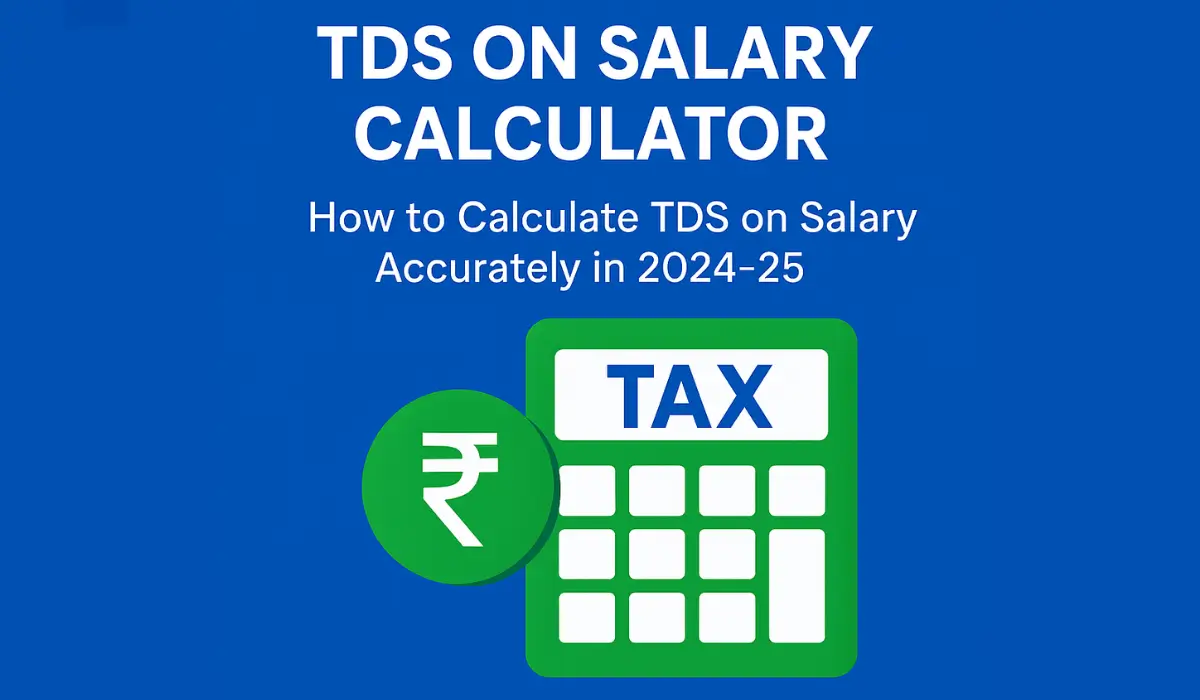Learn how to use a TDS on salary calculator to determine your tax deductions accurately. This guide covers TDS rates, exemptions, step-by-step calculations, and how HR Calcy simplifies the process.
In India, Tax Deducted at Source (TDS) on salary is calculated based on the Income Tax Slabs applicable for the financial year (FY). The employer deducts TDS under Section 192 of the Income Tax Act, 1961, while paying the salary to the employee.
Income Tax Calculator
(Old vs New Tax Regime Calculator)
| Head | Details/ Amt. |
|---|---|
| Gross Income | |
| Exemptions u/s 10 A (HRA etc.) | |
| Professional Tax | |
| Net Income under Salaries | 0.00 |
| Standard Deduction (Auto Applied) | 50000 |
| Deductions u/s 80 C (PF, PPF, Ins, ELSS, NPS: Max Rs.150000) | |
| Deductions u/s 80 CCD (NPS: Max Rs. 50000/-) | |
| Deductions u/s 80 D (Health Insurance: Max Rs. 35000/-) | |
| Deductions u/s 80 G (Eligible Donations) | |
| Deductions u/s 80 E (Education Loan Interest) | |
| Deductions u/s 80 TTA (FD/Post Office Interest: Max Rs. 40000/-) | |
| Tax Benefit u/s 24 (Home Loan Interest Paid: Max Rs. 200000/-) | |
| Total Deductions/Benefits | 0.00 |
Tax Deducted at Source (TDS) on salary is a crucial part of financial planning for salaried employees in India. Employers deduct TDS based on your income, applicable tax slabs, and exemptions. Calculating TDS manually can be complex, but a TDS on salary calculator simplifies the process, ensuring accuracy and compliance.
This comprehensive guide explains:
- What is TDS on salary?
- How is TDS calculated on salary?
- Key exemptions and deductions under the Income Tax Act
- Step-by-step process to use a TDS on salary calculator
- Latest updates for FY 2024-25
What is TDS on Salary?
TDS (Tax Deducted at Source) is the amount deducted by an employer before paying salary to an employee. The deducted tax is deposited with the government on behalf of the employee. The employer must issue Form 16, which contains details of salary paid and TDS deducted.
Who Deducts TDS on Salary?
- Employers (private companies, government organizations, or any entity paying salary)
- Applicable if salary exceeds the basic exemption limit (₹2.5 lakh for FY 2024-25)
When is TDS Deducted?
- Every month when salary is paid
- Based on estimated annual income and tax liability
How is TDS on Salary Calculated?
TDS on salary depends on:
- Gross Salary (Basic + HRA + Allowances + Bonuses)
- Exemptions & Deductions (HRA, LTA, Section 80C, 80D, etc.)
- Applicable Tax Slab (Old vs. New Tax Regime)
The TDS deduction depends on the employee’s estimated annual taxable income after considering exemptions, deductions, and investments.
Step-by-Step Calculation:
- Calculate Gross Salary
- Basic Salary
- Dearness Allowance (DA)
- House Rent Allowance (HRA)
- Special Allowances
- Bonuses & Commissions
- Other taxable perks
- Subtract Exemptions (Under Section 10)
- HRA Exemption (Least of):
- Actual HRA received
- 50% (Metro) / 40% (Non-Metro) of basic salary
- Rent paid – 10% of basic salary
- Leave Travel Allowance (LTA) (Actual travel cost, limited to 2 trips in a block of 4 years)
- Standard Deduction (₹50,000) (FY 2023-24 onwards)
- Other exemptions (e.g., medical allowance, transport allowance, etc.)
- HRA Exemption (Least of):
- Add Other Income (If Declared by Employee)
- Income from house property
- Capital gains
- Other sources (interest, dividends, etc.)
- Deduct Eligible Investments (Under Chapter VI-A)
- Section 80C (₹1.5 lakh): EPF, PPF, ELSS, Life Insurance, NSC, etc.
- Section 80D (Health Insurance): Up to ₹25,000 (self/family) + ₹50,000 (senior citizens)
- Section 80CCD(1B) (NPS): Additional ₹50,000
- Section 80G (Donations): As per eligible deductions
- Others (Education loan interest, disability benefits, etc.)
- Determine Taxable Income
Taxable Income = (Gross Salary – Exemptions – Deductions) + Other Income
- Apply Income Tax Slabs (FY 2023-24 & 2024-25 – New Tax Regime Default)
Income Range (₹) Tax Rate (New Regime) Tax Rate (Old Regime) 0 – 3,00,000 0% 0% 3,00,001 – 6,00,000 5% 5% (up to ₹5,00,000) 6,00,001 – 9,00,000 10% 20% (₹5,00,001-10L) 9,00,001 – 12,00,000 15% 30% (>₹10L) 12,00,001 – 15,00,000 20% – >15,00,000 30% – - Surcharge: 10% (if income > ₹50L), 15% (>₹1Cr), etc.
- Health & Education Cess: 4% on tax + surcharge
- Divide Yearly Tax by 12 for Monthly TDS Deduction
Monthly TDS = (Total Annual Tax) / 12
Key Points (TDS on Salary Policy)
- Employer’s Responsibility: Must deduct TDS if salary exceeds basic exemption limit (₹2.5L old regime / ₹3L new regime).
- Form 12BB: Employee must submit proof of investments/exemptions to the employer.
- Form 16: Issued by employer (shows salary breakup & TDS deducted).
- No TDS if Taxable Income ≤ ₹2.5L (Old) / ₹3L (New).
- New vs. Old Regime: Employee must choose (default is new regime unless opted out).
Example Calculation (FY 2024-25 – New Regime)
- Gross Salary: ₹10,00,000
- Standard Deduction: ₹50,000
- Taxable Income: ₹10,00,000 – ₹50,000 = ₹9,50,000
- Tax:
- 0-3L: 0
- 3-6L: 5% of ₹3L = ₹15,000
- 6-9L: 10% of ₹3L = ₹30,000
- 9-9.5L: 15% of ₹50,000 = ₹7,500
- Total Tax: ₹52,500
- Cess (4%): ₹2,100
- Net Tax: ₹54,600
- Monthly TDS: ₹54,600 / 12 = ₹4,550
Income Tax Slabs for FY 2024-25 (Old Regime)
| Income Range (₹) | Tax Rate |
|---|---|
| Up to ₹2.5 lakh | Nil |
| ₹2.5 – ₹5 lakh | 5% |
| ₹5 – ₹10 lakh | 20% |
| Above ₹10 lakh | 30% |
Income Tax Slabs for FY 2024-25 (New Regime)
| Income Range (₹) | Tax Rate |
|---|---|
| Up to ₹3 lakh | Nil |
| ₹3 – ₹6 lakh | 5% |
| ₹6 – ₹9 lakh | 10% |
| ₹9 – ₹12 lakh | 15% |
| ₹12 – ₹15 lakh | 20% |
| Above ₹15 lakh | 30% |
Step-by-Step Guide to Calculate TDS on Salary
Step 1: Determine Gross Salary
Calculate total earnings including:
- Basic Salary
- House Rent Allowance (HRA)
- Dearness Allowance (DA)
- Special Allowances
- Bonuses & Commissions
Step 2: Subtract Exemptions
Common exemptions include:
- HRA Exemption (Least of the following):
- Actual HRA received
- 50% of basic salary (metro) / 40% (non-metro)
- Rent paid minus 10% of basic salary
- Leave Travel Allowance (LTA)
- Standard Deduction (₹50,000)
Step 3: Apply Deductions Under Chapter VI-A
- Section 80C (₹1.5 lakh): EPF, PPF, ELSS, Life Insurance, etc.
- Section 80D (₹25,000 – ₹75,000): Health Insurance
- Section 24(b): Home Loan Interest (Up to ₹2 lakh)
Step 4: Calculate Taxable Income
Taxable Income = Gross Salary – Exemptions – Deductions
Step 5: Apply Tax Slab Rates
Use the applicable tax regime (Old or New) to compute tax liability.
Step 6: Deduct Rebates (If Applicable)
- Section 87A Rebate: Up to ₹12,500 (for income up to ₹5 lakh under Old Regime)
Step 7: Add Surcharge & Cess
- Health & Education Cess: 4% on total tax
How a TDS on Salary Calculator Simplifies the Process
Manually calculating TDS is error-prone. A TDS on salary calculator automates the process by:
- Considering all exemptions and deductions
- Applying the latest tax slabs
- Providing instant, accurate results
Why Use HR Calcy’s TDS Calculator?
HR Calcy offers a free, user-friendly TDS on salary calculator that:
- Computes tax under both Old & New regimes
- Accounts for all exemptions (HRA, LTA, etc.)
- Updates with latest tax laws
- Generates Form 16-ready reports
Key Changes in TDS on Salary for FY 2024-25
- Revised Tax Slabs under New Regime (Default from FY 2023-24)
- Increased Standard Deduction (₹50,000)
- Higher Leave Encashment Exemption (₹25 lakh for non-government employees)
- Simplified TDS Compliance (Lower penalties for employers)
Common Mistakes to Avoid in TDS Calculation
- Ignoring exemptions (HRA, LTA)
- Incorrectly applying tax regime (Old vs. New)
- Missing deductions (Section 80C, 80D)
- Not considering cess and surcharge
Key Takeaways
- TDS on salary is deducted by employers based on income tax slabs.
- Use a TDS on salary calculator for quick, error-free tax computation.
- Exemptions (HRA, LTA) and deductions (Section 80C, 80D) reduce taxable income.
- The New Tax Regime offers lower rates but fewer deductions.
- HR Calcy’s TDS Calculator ensures compliance and accuracy.
Understanding TDS on salary is essential for financial planning. A TDS on salary calculator eliminates guesswork, ensuring you pay the right tax and maximize savings. For seamless tax calculations, explore HR Calcy’s advanced tools today.
By following this guide, you can confidently compute TDS, optimize deductions, and stay compliant with tax laws in 2024.
Conclusion
TDS on salary is calculated based on projected annual income after exemptions & deductions. Employees can lower TDS by submitting investment proofs (under old regime). The employer adjusts TDS monthly based on the employee’s declarations.
FAQ
What is TDS on salary?
TDS (Tax Deducted at Source) on salary is a tax deducted by the employer before paying the salary to the employee, as per the applicable income tax slabs.
How is TDS on salary calculated in 2024-25?
TDS on salary is calculated based on the employee’s total taxable income after exemptions, deductions, and applicable tax slabs under the chosen tax regime (old or new).
What is the TDS exemption limit for salaried employees?
No TDS is deducted if the total taxable income is below the basic exemption limit of ₹2.5 lakh (old regime) or ₹3 lakh (new regime) for FY 2024-25.
Which deductions are allowed under the old vs. new tax regime?
Under the old tax regime, deductions like HRA, 80C, 80D, and LTA are allowed. The new tax regime offers a lower tax rate but allows only the standard deduction of ₹50,000.
What is the standard deduction for salaried employees in 2024-25?
The standard deduction for salaried employees and pensioners in FY 2024-25 is ₹50,000 under both the old and new tax regimes.
How can I calculate my TDS on salary online?
You can use an online TDS calculator like HR Calcy’s TDS on Salary Calculator to determine the exact TDS amount based on your salary and deductions.
Can I get a refund if excess TDS is deducted from my salary?
Yes, if excess TDS is deducted, you can claim a refund by filing your income tax return (ITR) and showing the correct taxable income.
What is Form 16, and why is it important?
Form 16 is a certificate issued by employers that provides details of salary paid and TDS deducted. It is essential for filing income tax returns.
When is the due date for depositing TDS deducted on salary?
The employer must deposit the deducted TDS by the 7th of the following month, except for March, where the due date is April 30.
What happens if the employer fails to deduct or deposit TDS?
Failure to deduct or deposit TDS results in penalties, interest charges, and disallowance of salary expenses for the employer.
Professional Quiz With Free Certificate
Resources
& Finance
Technology
Marketing
& Projects
& Supply Chain

